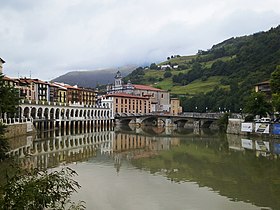| Battle of Tolosa (1813) | |||||||
|---|---|---|---|---|---|---|---|
| Part of the Peninsular War | |||||||
 Tolosa lies in the deep valley of the Oria River. | |||||||
| |||||||
| Belligerents | |||||||
|
|
| ||||||
| Commanders and leaders | |||||||
|
|
| ||||||
| Strength | |||||||
|
|
| ||||||
| Casualties and losses | |||||||
|
24 June: 193 26 June: 619 |
24 June: 300 26 June: 400+ | ||||||
Vitoria and the Pyrenees, 1813–1814
The Battle of Tolosa (26 June 1813) saw a British-Portuguese-Spanish column led by Thomas Graham attempt to cut off a retreating Franco-Italian force under Maximilien Sébastien Foy. Assisted by Antoine Louis Popon de Maucune's division, which fortuitously appeared, the French parried Graham's initial attacks then slipped away when threatened with envelopment. The town of Tolosa is located about 20 kilometres (12 mi) south of San Sebastián. The clash occurred during the Peninsular War, part of the wider Napoleonic Wars.
In the late spring of 1813, the Allied army of Arthur Wellesley, Marquess of Wellington launched a powerful offensive designed to drive King Joseph Bonaparte's Imperial French army from Spain. On 21 June, Wellington's army inflicted a decisive defeat on Joseph's troops at the Battle of Vitoria. As the defeated French armies withdrew toward the Pyrenees, Wellington tried to intercept Foy's column in the north and Bertrand Clausel's forces in the south. Neither Foy nor Clausel had fought at Vitoria. Graham caught up with Foy's column, but after some fighting, the French got away. Clausel also managed to avoid being cut off, but except for the Sieges of San Sebastian and Pamplona, northern Spain was soon free of French occupation. The next pitched battle was the Battle of the Pyrenees which began on 25 July.

